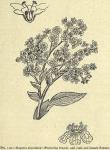 The dried panicles of the pistillate flowers of Hage'nia abyssin'ica Gmelin, without the presence of more than 10 per cent. of the staminate flowers, other parts of the tree, or other foreign matter. Reject any portions of the stem over 3 mm. in diameter and any binding material before the drug is powdered or used.
The dried panicles of the pistillate flowers of Hage'nia abyssin'ica Gmelin, without the presence of more than 10 per cent. of the staminate flowers, other parts of the tree, or other foreign matter. Reject any portions of the stem over 3 mm. in diameter and any binding material before the drug is powdered or used.
HABITAT.—Abyssinia.
DESCRIPTION.—Small, reddish, pistillate flowers, consisting of two reddish bracts and a calyx of five reddish, hairy sepals inclosing one or two nutlets. They come into market in cylindrical bundles of the compressed panicles, or detached, on short, hairy peduncles; odor tea-like; taste bitter and nauseous. In trade the "brown" and "red" kusso are known. The former are mixed with male flowers. In the "red," the best variety, the sepals are reddish; in the "brown" they are greenish or brownish and smaller.
Powder.—Light brown. Characteristic elements: These are to be found in the glandular trichomes consisting of stalks, 2 to 3 celled, head 1, 2, 4 celled; non-glandular trichomes, one-celled, curved; few ellipsoidal pollen grains with 3 pores. Powder seldom dispensed.
CONSTITUENTS.—The chief constituents are kosotoxin (amorphous), a muscle poison, and protokosin (crystalline), inactive. Kosotoxin with baryta water yields a neutral body said to be identical with commercial kosin, an active principle soluble in alkalies; a neutral principle, Koussein (dose: 15 to 30 gr.) is marketed; tannin 24 per cent., and a tasteless and an acrid resin. Ash, not more than 9 per cent.
Preparation of Kosin.—Heat cusso repeatedly with alcohol to which calcium hydrate has been added, boil residue with water, mix liquids, filter, and distil. Kosin is then precipitated by treating the solution with acetic acid. Is in flocculent form, soon becoming dense and resin-like. Purified by crystallization.
ACTION AND USES.—Taenifuge. Dose: 15 Gm. (240 gr.).
Fluidextractum Cusso (U.S.P. 1890). Dose: 1 to 4 fl. dr. (4 to 15 mils).

